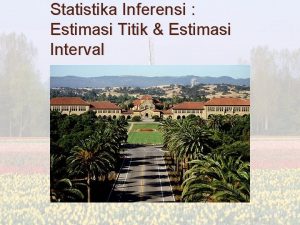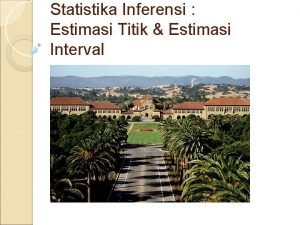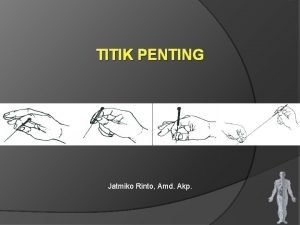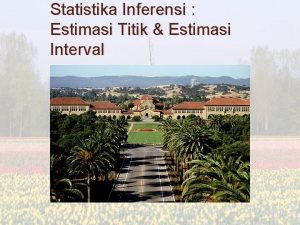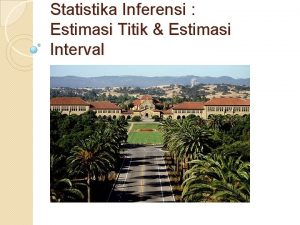Awit sa GSK Titik ug musika ni Fr















































- Slides: 47

Awit sa GSK (Titik ug musika ni Fr. Amado L. Picardal, CSs. R) Koro: Katilingban masaksihon, katilingban maampoon, Katilingbang nag-alagad, kini ang GSK (2 X) Kita ang katilingban sa mga tinun-an ni Jesus nagkahiusa, nagpadayon sa misyon ni Kristo. Katawhang propeta, pari ug alagad Ang katilingban sa kabos - Simbahan sa kabos. Kita ang katilingban sa mga tinun-an ni Jesus Gihiusa, gilambigit sa atong Ginoo. Nag-inambitay sa Pulong ug Yukaristiya, ug mga kabtangan, suod nga mga higala.

Koro: Katilingban masaksihon, katilingban maampoon, Katilingbang nag-alagad, kini ang GSK (2 X) Kita ang katilingban sa mga tinun-an ni Jesus namati sa pulong sa atong Ginoo nagsaksi, nagsangyaw sa maayong balita sa atong kaluwasan ug sa Gingharian. Kita ang katilingban sa mga tinun-an ni Jesus nag-ampo ug nagsimba sa atong Ginoo andam nga mohalad sa'tong kinabuhi sama ni Kristo, labaw nga pari. (koro)

Koro: Katilingban masaksihon, katilingban maampoon, Katilingbang nag-alagad, kini ang GSK (2 X) Kita ang katilingban sa mga tinun-an ni Jesus katilingbang nag-alagad sa nanginahanglan. nagpatunhay sa hustisya ug sa kalinaw nakigbisog, nagpalambo sa Gingharian. Kita ang katilingban sa mga tinun-an ni Jesus gilangkoban sa kabos, nagdapig sa kabos. Way laing gisaligan, gawas sa Ginoo Maabtikong nagasalmot sa misyon ni Kristo. (Koro)

Basic Ecclesial Communities: Ecclesiological Perspective Rev. Amado L. Picardal, CSs. R, STD

Dominant Image of the Church before Vatican II A Church that is massive, highly institutionalized and impersonal. A church where members live in anonymity and do not feel a sense of belonging. n A Church that is identified exclusively with the hierarchy and that ignores the laity. n A Church that is exclusively liturgical and sacramental, a Church that is not concerned about the situation of poverty, injustice, violence and the destruction of the environment. n A Church that is associated with the rich and n

Vatican II Vision of a Renewed Church

The Call for Church Renewal John XXIII convened Vatican II to renew the Church -- for “aggiornamento” n It was a council of the Church on the Church n

Ecclesiological Themes in Vatican II n Communion n People of God participating in the mission of Christ as Priest, Prophet & King (Hierarchical Leadership at the service of the People of God)

Vatican II Vision of a Renewed Church Prophetic (witnessing) Priestly Kingly (worshipping)(servant)

Paradigm Shift in Vatican II From a highly institutionalized model to a more communitarian model n From a highly clericalized model to a greater emphasis on the active participation of the lay-faithful in the life and mission of the Church n From a narrow spiritualistic/cultic outlook to a holistic perspective which encourages involvement in the temporal/social order n

Thus, the dominant institutional/sacramental model has been replaced by a more holistic vision of the Church. n The Church is not just an institution, it is also a community whose members are in communion with God and with one another. n It is not just a worshipping community, it is also a prophetic and servant community. Its mission is not only spiritual, it is also temporal. The Church is not only concerned about heaven, it is also concerned about the earth and all its problems. n

Thrust of Vatican II Ecclesiology: Renewed Church A communitarian vision of the Church n A holistic vision of the Church – people of God that is prophetic, priestly, kingly (servant). n Concern for the temporal order (economic, political, cultural) – for justice & peace n Lay Participation in the Church’s life & mission n Renewal of the Clergy – a more holistic n

Post-Conciliar Reception and Implementation From 1965 up to the present -- reception and implementation of the council’s decree and spirit after the council n The task of renewing the Church now falls on the local Churches n

MSPC as Reception of Vatican II n MSPC I (1 st Mindanao-Sulu Pastoral Conference) in 1971 n The theme: The Church of Mindanao-Sulu: A Witnessing, Worshipping & Serving Community n Note: the communitarian and holistic perspective of Vatican II in MSPC theme. n The promotion of GKK (Gagmayng Kristohanong Katilingban) n GKK as worshipping, witnessing and serving communities. (katilingbang maampoon, masaksihon ug maalagaron)

MSPC I vision of the Church and the BECs Community Witnessing Worshipping Serving

PCP II Vision of the Church The PCP II has adopted the image of the early Church in Acts and the ecclesiology of Vatican II as its basis for its vision of a renewed Church: Community of Disciples living in Communion participating in the mission of Christ as priestly, prophetic & kingly people and as the Church of the Poor

PCP II Vision of the Church Community of Disciples Prophetic (witnessing) Priestly Kingly (worshipping)(servant)

BECs as Expression of the PCP II Vision of a Renewed Church “Our vision of the Church as communion, participation and mission, about the Church as priestly, prophetic, & kingly people, and as a Church of the Poor- a church that is renewed - is today finding expression in one ecclesial movement. This is the movement to foster Basic Ecclesial Communities. ” par 137

PCP II Vision of BECs: Community of Disciples Prophetic (witnessing) Priestly Kingly (worshipping)(servant)

Description: PCP II “They are small communities of Christian, usually of families who gather around the Word of God & the Eucharist. These communities are united to their pastors but are ministered to regularly by lay leaders. The members know each other by name & share not only the Word of God & the Eucharist but also their concerns both material & spiritual They have a strong sense of belongingness & responsibility for one another” (par 138)

“Usually emerging from the grassroots among poor farmers & workers, BECs consciously strive to integrate their faith & their daily life. They are guided & encouraged by regular catechesis. Poverty & their faith urge their members towards solidarity with one another, action for justice & towards a vibrant celebration of life in the

Characteristics of BECs 1. 2. 3. 4. 5. Small communities whose members are united to one another and their pastors (koinonia) They share the word of God and are guided by regular catechesis (kerygma) – prophetic community They gather around the Eucharist and have a vibrant celebration of life in the liturgy (leitorgia) – priestly community They share their material concerns & get involved in action for justice & peace and social transformation. (diakonia) – kingly/servant community They emerge among the poor & empower the

BECs: Terminology BECs - generic term for small faithcommunities emerging at the grassroots (BCCs, SCCs, GKKs, GSK, MSKs, Kris. Ka, Damayan & other local names)

Communities They are communities, not organizations, prayer groups, societies or associations. They are not specialized groups but stable environment. The members often live in close proximity and interact with each other regularly. (family/neighborhood groupings of 8 -12 members are part of the community but they cannot be equated to the community)

Basic Communities They are basic communities, because of their size, the quality of relationship among the members and their social location (base, grassroots)

Ecclesial They are referred to as ecclesial because they are considered as a way of being Church. They are the church at the microcosm, the church at the grassroots – in the neighborhood & the village.

BECs a Way of Being Church Through the BECs, the Church is truly experienced as a community of disciples. n The lay faithful experience communion. n The lay faithful live out their vocation as people of God that participates in Christ’s prophetic, priestly and kingly mission n The church becomes truly the Church of the Poor n

The Church as Communion The image of Church as communion emphasizes the communitarian and interpersonal dimension of the Church. n Ecclesial communion can be lived out in various levels: n Universal (communion of local Churches) n Local (communion of dioceses/parishes) n Parish (communion of BECs) n BEC (communion of individual members, cells and families) n

BECs as Expression of Communion According to John Paul II, the BECs can be “true expression of communion and a means towards construction of a more profound communion. ” n In the BECs the members have a strong sense of belonging & responsibility for one another. n The members experience the bond of unity which is based on shared faith, celebrated in the breaking of the bread, concretely expressed in the sharing of material goods. n

Living in Communion as BECs A new way of being Church means looking at the parish as network of BECs – a communion of communions. n The members of BECs experience communion among themselves, while each BEC is linked to other BECS. n Although ministered by lay leaders, the BECs maintain a bond of communion with their pastors – the parish priests & the bishop. n

Church as People of God: Prophetic, Priestly & Kingly Vatican II & PCP II view the Church as a people of God that is prophetic, priestly & kingly by nature and mission. n This image of the Church asserts that all the baptized share in the life and mission of the Church. n Thus, the laity have the right and responsibility to actively participate in the prophetic, priestly and kingly mission of the Church n

Prophetic, Priestly, Kingly People This provides us with a holistic view of the Church. n It negates the exclusively liturgical/ sacramental image of the Church. n The Church is not only a worshipping community, it is also a prophetic and servant community. n This image of the Church can be experienced by ordinary lay people at the BECs since these are prophetic, priestly and servant n

n n n The Church as Prophetic People It has the mission of proclaiming the Good news – a mission of evangelization & catechesis. It is also called to be the conscience of society – this is the mission of denouncing evil and all its manifestation: injustice, oppression, violence, the culture of death. It has announces the Good News of liberation & salvation, of life, justice & peace. It witnesses to the Word & calls people to conversion. The prophetic mission of the church can be exercised in the universal and local level by the

BECs as Prophetic Communities It is in and through BECs that lay people can participate in the mission of the Church. n The BECs come together to listen to the Word, to proclaim and give witness to it. n They are evangelized and evangelizing communities, they are witnessing communities. n BECs have the task of evangelizing & catechizing families, neighborhood communities and barangays. n It is within the BECs that the Gospel values n

BECs as Prophetic Communities BECs carry out their prophetic & evangelizing mission whenever they come together in their homes and chapels for their bible-service to reflect/discern on the word of God and their concrete situation.

The Church as Priestly People The Church is a worshipping and celebrating community. n The priesthood of the faithful is expressed in the full and active participation in the liturgical and sacramental celebration. n The lay-faithful can exercise their priestly mission not only in the parish level but also in BECs. n

BECs as Priestly Communities n n n They gather weekly in their chapel to celebrate the Liturgy of the Word presided by lay leaders. Their monthly or bi-monthly celebration of the Eucharist with the parish priest is festive and well participated. They have communal liturgies or rituals for various occasions (birthdays, planting & harvesting, sickness, wakes & funerals)

The Kingly/Servant People The Church as a Kingly People is called to be a Servant Church. n The mission of the church is not purely spiritual. n The Church is called to be attentive to the situation of poverty, injustice, armed conflict, human rights violation, ecological degradation, n PCP II calls for a renewed social apostolate and for the Church to actively participate in the work for justice, peace, development & integrity of creation. The church is to be n

BECs as Serving Communities It is in & through the BECs that lay people can actively participate in the process of social transformation. n In response to the problem of poverty, they can set up socio-economic projects (IGP, livelihood, cooperatives, sustainable agriculture, etc. ) n

BECs as Serving Communities In response to the armed conflict, they can establish peace zones and be part of the peace movement that pressures the government and revolutionary forces to pursue the peace process.

BECs as Serving Communities n n n To ensure clean and honest elections, the BECs can be mobilized to help the PPCRV or NAMFREL. They can help in defending the environment They can be mobilized to participate in nationwide prayer rallies and vigils for various causes taken up by the CBCP or the diocese

The Church of the Poor The most popular image of the Church in PCP II – the Church of the poor n This requires that the leaders and members of the Church embrace evangelical poverty, live a simple life-style and share their resources with the poor. n Those who are not poor are called to make an option for the poor, to be in solidarity with the poor and to defend their rights. n The poor members are empowered & called to actively participate in the life & mission of n

BECs as expression of the Church of the Poor The BECs enable the poor to embrace evangelical poverty and to actively participate in the Church’s prophetic, priestly and pastoral mission n The poor are not only evangelized, they also become evangelizers n The poor are not just passive recipients of aid, they are active participants in the process of social transformation. n

Conclusion The BECs are indeed a new way of being Church. They are the most local expression of the Church. n Through the BECs, the Church can truly be experienced as Community of Disciples, whose members live in communion, and participate in the mission of Christ as worshipping, witnessing and serving communities, and as the Church of the poor. n They are indeed the concrete realization of the vision of a renewed Church of Vatican II and PCP II n

Awit sa GSK (Titik ug musika ni Fr. Amado L. Picardal, CSs. R) Koro: Katilingban masaksihon, katilingban maampoon, Katilingbang nag-alagad, kini ang GSK (2 X) Kita ang katilingban sa mga tinun-an ni Jesus nagkahiusa, nagpadayon sa misyon ni Kristo. Katawhang propeta, pari ug alagad Ang katilingban sa kabos - Simbahan sa kabos. Kita ang katilingban sa mga tinun-an ni Jesus Gihiusa, gilambigit sa atong Ginoo. Nag-inambitay sa Pulong ug Yukaristiya, ug mga kabtangan, suod nga mga higala.

Koro: Katilingban masaksihon, katilingban maampoon, Katilingbang nag-alagad, kini ang GSK (2 X) Kita ang katilingban sa mga tinun-an ni Jesus namati sa pulong sa atong Ginoo nagsaksi, nagsangyaw sa maayong balita sa atong kaluwasan ug sa Gingharian. Kita ang katilingban sa mga tinun-an ni Jesus nag-ampo ug nagsimba sa atong Ginoo andam nga mohalad sa'tong kinabuhi sama ni Kristo, labaw nga pari. (koro)

Koro: Katilingban masaksihon, katilingban maampoon, Katilingbang nag-alagad, kini ang GSK (2 X) Kita ang katilingban sa mga tinun-an ni Jesus katilingbang nag-alagad sa nanginahanglan. nagpatunhay sa hustisya ug sa kalinaw nakigbisog, nagpalambo sa Gingharian. Kita ang katilingban sa mga tinun-an ni Jesus gilangkoban sa kabos, nagdapig sa kabos. Way laing gisaligan, gawas ang Ginoo Maabtikong nagasalmot sa misyon ni Kristo. (Koro)
 Campuran homogen tersusun dari titik-titik dan titik-titik
Campuran homogen tersusun dari titik-titik dan titik-titik Sel adalah pertemuan antara titik-titik dan titik-titik
Sel adalah pertemuan antara titik-titik dan titik-titik Uri ng tempo sa musika
Uri ng tempo sa musika Halimbawa ng krayterya
Halimbawa ng krayterya Kahulugan at katangian ng korido
Kahulugan at katangian ng korido Ano ang kahulugan ng nagulantang
Ano ang kahulugan ng nagulantang Ano ang nais mong
Ano ang nais mong Gsk glaxosmithkline
Gsk glaxosmithkline Gsk.com careers
Gsk.com careers Tijana sukilovic
Tijana sukilovic Gsk sanofi
Gsk sanofi Gsk mission
Gsk mission Gsk respiratorio
Gsk respiratorio Codigos miscelaneos cnc
Codigos miscelaneos cnc Setproxy.gsk.com
Setproxy.gsk.com My summer holidays listening
My summer holidays listening Yang merupakan garis singgung adalah
Yang merupakan garis singgung adalah Tingkat ketelitian pengukuran jangka sorong
Tingkat ketelitian pengukuran jangka sorong Manfaat membaca senyap
Manfaat membaca senyap Materi muatan listrik
Materi muatan listrik Kukenang jasamu pembela nusa bangsa
Kukenang jasamu pembela nusa bangsa Jari-jari 14 dm tinggi titik-titik dm volume 9240 dm
Jari-jari 14 dm tinggi titik-titik dm volume 9240 dm Permainan bola voli dipimpin oleh titik-titik wasit
Permainan bola voli dipimpin oleh titik-titik wasit Formula jarak koordinat
Formula jarak koordinat Tambahkanlah
Tambahkanlah Perhatikan 8 persegi satuan berikut
Perhatikan 8 persegi satuan berikut Lempeng prisma tiang granular merupakan titik-titik tanah
Lempeng prisma tiang granular merupakan titik-titik tanah 2 satuan segitiga titik-titik satuan persegi
2 satuan segitiga titik-titik satuan persegi Contoh perangkat lunak menggambar adalah
Contoh perangkat lunak menggambar adalah Bidang adalah
Bidang adalah Perspektif 1 titik hilang kubus
Perspektif 1 titik hilang kubus Contoh varian
Contoh varian Do you like to sing?
Do you like to sing? Penggunaan tanda titik
Penggunaan tanda titik Panjang ruas garis ae adalah
Panjang ruas garis ae adalah Gajah gajah kowe tak kandani jah mripat kaya
Gajah gajah kowe tak kandani jah mripat kaya Miumiu
Miumiu Eko is titik-titik dan ari
Eko is titik-titik dan ari We... to the college yesterday
We... to the college yesterday Ang senakulo ay isang halimbawa ng tulang
Ang senakulo ay isang halimbawa ng tulang Tausug background
Tausug background Kahulugan ng tula
Kahulugan ng tula Pag aralan ang talahanayan sa ibaba
Pag aralan ang talahanayan sa ibaba Ang tawag sa mamamayan ng pilipinas
Ang tawag sa mamamayan ng pilipinas Iba't ibang makrong kasanayan
Iba't ibang makrong kasanayan Ako at ang aking tahanan grade 1
Ako at ang aking tahanan grade 1 Pagkakatulad ng ibong adarna at florante at laura
Pagkakatulad ng ibong adarna at florante at laura Dalawang saknong na tula
Dalawang saknong na tula





















































